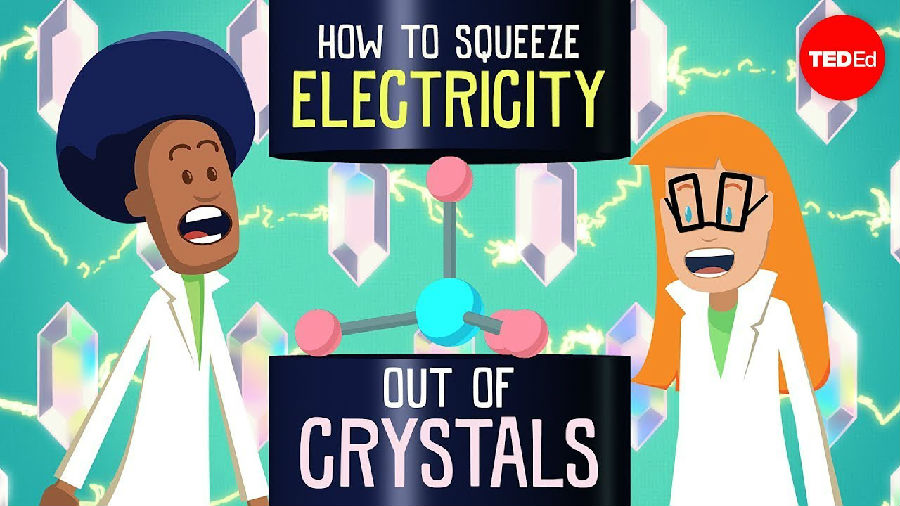(单词翻译:单击)
This is a crystal of sugar.
这是糖的结晶体。
If you press on it, it will actually generate its own electricity.
你在按压它时,它实际上会产生电荷。
How can this simple crystal act like a tiny power source? Because sugar is piezoelectric.
这个简单的晶体是怎样扮演一个小发电站的角色呢?因为糖是压电体。
Piezoelectric materials turn mechanical stress,
压电材料会把机械应力,
like pressure, sound waves, and other vibrations into electricity and vice versa.
如压力、声波还有其他振动转化为电力,反之亦然。
This odd phenomenon was first discovered by the physicist Pierre Curie and his brother Jacques in 1880.
这种奇特现象是在1880年被物理学家皮埃尔·居里和他的弟弟雅克首次发现的。
They discovered that if they compressed thin slices of certain crystals,
他们发现如果他们压缩一些细小的晶体片,
positive and negative charges would appear on opposite faces.
正电荷和负电荷会出现在相反两面。
This difference in charge, or voltage,
电荷或者说电压的不同,
meant that the compressed crystal could drive current through a circuit, like a battery.
意味着被压缩的晶体可以通过电路驱动电流,像是电池一样。
And it worked the other way around, too.
它也可以朝着另一方向运行。
Running electricity through these crystals made them change shape.
通过这些晶体运作电力会使晶体的形状发生变化。
Both of these results, turning mechanical energy into electrical,
这里有两种结果,一种是将机械能转化为电能,
and electrical energy into mechanical, were remarkable.
另一种则是将电能转化为机械能,两者都是意义非凡的。
But the discovery went uncelebrated for several decades.
但这项发现在几十年间都没有受到人们的关注。
The first practical application was in sonar instruments used to detect German submarines during World War I.
第一次实际应用是被使用到声呐仪器中,这种声呐仪器在第一次世界大战时被用于探测德国潜艇。
Piezoelectric quartz crystals in the sonar's transmitter vibrated when they were subjected to alternating voltage.
声呐发射机中的压电石英晶体在受到交变电压影响时会产生振动。
That sent ultrasound waves through the water.
从而在水中发送超声波。
Measuring how long it took these waves to bounce back from an object revealed how far away it was.
通过测量这些超声波触碰到一个物体反弹回来所花费的时间,可以知道与物体相隔的距离。
For the opposite transformation, converting mechanical energy to electrical,
如果是另一种转化,将机械能转化为电能,
consider the lights that turn on when you clap.
可以想想那些当你鼓掌时就会亮起来的灯。
Clapping your hands send sound vibrations through the air and causes the piezo element to bend back and forth.
你在鼓掌的同时会在空气中产生声音振动,这会让压电元件来回弯曲。
This creates a voltage that can drive enough current to light up the LEDs,
由此产生的电压会驱使足够的电流让LED灯发亮,
though it's conventional sources of electricity that keep them on. So what makes a material piezoelectric?
不过这已经算是让灯亮起来的传统电力来源了。那么是什么让材料带有压电性呢?
The answer depends on two factors: the materials atomic structure, and how electric charge is distributed within it.
这取决于两个因素:材料的原子结构,还有电荷在其内部的分布。
Many materials are crystalline, meaning they're made of atoms or ions arranged in an orderly three-dimensional pattern.
很多材料都是晶体状的,意味着它们是由原子或者离子组成的,它们排列成一个有序的三维模型。
That pattern has a building block called a unit cell that repeats over and over.
这个模型的基础构件叫晶胞,材料中会有一个又一个重复的晶胞。

In most non-piezoelectric crystalline materials,
在绝大多数非压电性晶体材料中,
the atoms in their unit cells are distributed symmetrically around a central point.
晶胞里面的原子是对称分布在一个中心点周围的。
But some crystalline materials don't possess a center of symmetry making them candidates for piezoelectricity.
但一些晶体材料并没有对称中心,这使它们得以带有压电性。
Let's look at quartz, a piezoelectric material made of silicon and oxygen.
我们来看看石英,这是一种由硅和氧组成的压电材料。
The oxygens have a slight negative charge and silicons have a slight positive,
氧带有轻微的负电荷,而硅则带有轻微的正电荷,
creating a separation of charge, or a dipole along each bond.
这创造出电荷分离,或者说是每个键上的偶极。
Normally, these dipoles cancel each other out, so there's no net separation of charge in the unit cell.
一般情况下,这些偶极会相互抵消,所以在胞晶里没有电荷的净余分离。
But if a quartz crystal is squeezed along a certain direction, the atoms shift.
但如果石英晶体受到某一特定方向的挤压,原子就会发生转移。
Because of the resulting asymmetry in charge distribution, the dipoles no longer cancel each other out.
因为电荷分布的非对称性,偶极不再相互抵消。
The stretched cell ends up with a net negative charge on one side and a net positive on the other.
这个受到拉伸的晶胞一边带有负电荷,而另一边则带有正电荷。
This charge imbalance is repeated all the way through the material,
这种电荷不平衡的情况会在材料中重复出现,
and opposite charges collect on opposite faces of the crystal.
极性相反的电荷会在晶体的相反面上累积。
This results in a voltage that can drive electricity through a circuit.
这促使电压的产生,电压能够通过电路驱动电力。
Piezoelectric materials can have different structures.
压电材料可以有不同的结构。
But what they all have in common is unit cells which lack a center of symmetry.
但它们有一个共同点就是它们的晶胞中都没有对称中心。
And the stronger the compression on piezoelectric materials, the larger the voltage generated.
而且施加给压电材料的力越强,产生的电压就越大。
Stretch the crystal, instead, and the voltage will switch, making current flow the other way.
拉伸晶体,电压就会发生改变,导致电流反向流动。
More materials are piezoelectric than you might think.
压电材料或许比你想象中的还要多。
DNA, bone, and silk all have this ability to turn mechanical energy into electrical.
DNA、骨骼还有丝绸,它们都可以将机械能转化为电能。
Scientists have created a variety of synthetic piezoelectric materials
科学家已经创造出各种各样的合成压电材料,
and found applications for them in everything from medical imaging to ink jet printers.
并且将它们广泛应用在从医学影像到喷墨打印机的领域中。
Piezoelectricity is responsible for the rhythmic oscillations of the quartz crystals that keep watches running on time,
压电性还会产生有节奏的振动,这是石英晶体得以让钟表准时运作的原因,
the speakers of musical birthday cards,
还能作为音乐生日卡片上的扬声器,
and the spark that ignites the gas in some barbecue grill lighters when you flick the switch.
还有在你轻打开关的时候,在烧烤架上产生让汽油点燃的火花。
And piezoelectric devices may become even more common since electricity is in high demand and mechanical energy is abundant.
压电设备或许会越来越普及,因为电力需求量大而机械能又极其丰富。
There are already train stations that use passengers' footsteps to power the ticket gates and displays
已经有火车站利用乘客脚步这一机械能来给检票门和显示器提供电力,
and a dance club where piezoelectricity helps power the lights.
还有一个跳舞俱乐部利用压电性提供照明。
Could basketball players running back and forth power the scoreboard?
来回跑动的篮球运动员可以给记分牌提供电力吗?
Or might walking down the street charge your electronic devices? What's next for piezoelectricity?
沿街步行的同时还能让你的电子设备充上电吗?压电性的下一种可能会是什么?


